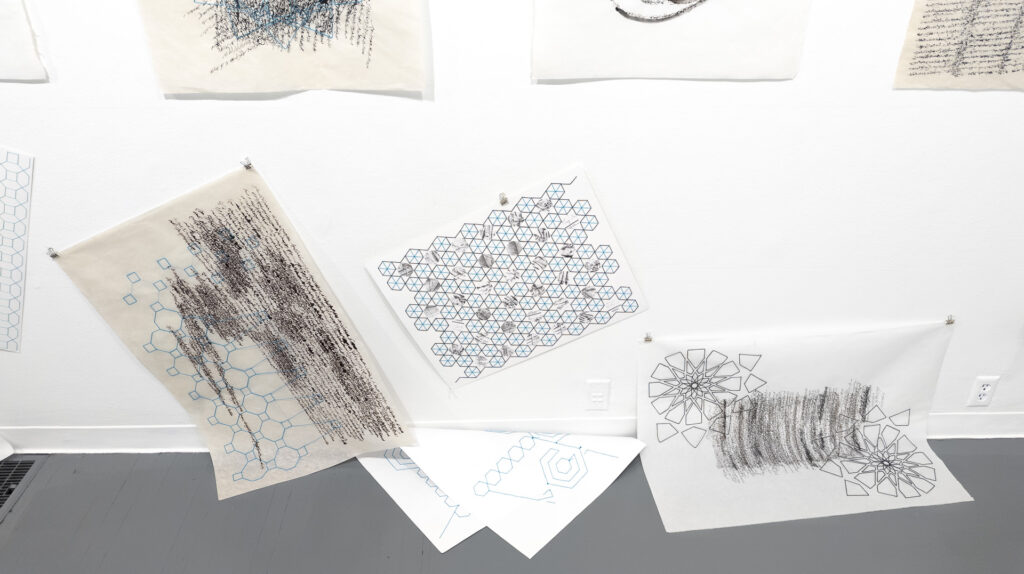A pile on the floor! Work by Nina Ghanbarzadeh *IN PERSON*

On view: January 14–April 8, 2023 | Reception: Fri. Feb. 17 | 5–8 PM CST
VIEW EXHIBITION
ABOUT THE EXHIBITION:
This exhibition celebrates my mother tongue—Farsi—and the art of geometric patterns, which has direct relation to nature and the cosmos. It highlights the importance of unity, logic, and order in the patterns.
I grew up in a culture where patterns, whether geometric or vegetal, are everywhere. Delicate, hand-woven Persian rugs with their brilliant colors and designs cover the floors of every Iranian home. I remember playing on them with our toys or coloring books. Geometric patterns cover walls, mosques, and buildings, and they get printed on calendars, books, and posters. When you are surrounded by them, you don’t think about them—they come to you so naturally. And so it is with my (and everyone’s) mother tongue. Even after two decades of living in the U.S., I think in Farsi because it comes to me effortlessly. English comes next. I am in constant translation between my two languages just to make sure that I can express how I feel or think fully. This is not a weakness but a strength—the ability to switch in between the two languages or translate instantly in real time is a skill.
This body of work came out of a comment that I received about a year ago. I was told that there is a danger of “Bones are used in Persian Khatam I,” a drawing of mine from 2020, becoming decorative only! This work was inspired by patterns that are found on Persian marquetry (khatam) objects such as picture frames, boxes, doors, etc. My intention in creating the drawing was to highlight the tedious process of designing and making marquetry objects. I was also told the only works in the submitted portfolio that were acceptable were the ones in which English sentences could be read (2018’s “This is written from right to left” and 2022’s “This sentence is written in two languages”). Otherwise, the entire portfolio could be on “a pile on the floor”!
I found that comment so biased and unfair. Though my works that feature written language are rendered in Farsi, those works are not totally ambiguous because I offer titles in English. But some people are not even ready for that, or they don’t want it at all. I have been trying to understand what it is about my works that make them uncomfortable or unacceptable. I am not the only artist who uses text as image, and I wonder why a select few get celebrated and others get dismissed. And why could my works be reduced to “a pile on the floor” despite my decade-long art practice and research?
That comment gave voice to the geometric patterns in my drawings, amplifying the use of written language. I hope that viewers can see past notions of legibility to find beauty in the curves, dots, and slanted lines in the writings, and see the one unified composition. I also want to highlight where these complex patterns, with their beautiful interweaving, originate from: a circle. The overlap of five or seven circles (and the repetition of them) is the basic unit for creating the grid system of squares and triangles. This is the infrastructure without which the colorful patterns cannot exist. The beauty of this vital grid system is that every artist can design their own patterns. Using a circle as the first step toward drawing a complex, never-ending pattern, refers to the One and One God Only (The Creator) from whom everything else originates.
I hope this body of work compels the viewers to do their own investigation into the history of geometric patterns and perhaps start drawing them. The process of drawing and coloring the patterns is meditative, one of many reasons that keeps me drawing them.
ABOUT THE ARTIST:
Nina Ghanbarzadeh is a Wisconsin visual artist and an entrepreneur taking a universal approach to written language in her art. She emigrated from Tehran, Iran, in 2001. Nina earned her Bachelor of Fine Arts degree in painting, drawing, and graphic design from the University of Wisconsin–Milwaukee in 2013 and completed a two-year Artist in Residency Program with Redline Milwaukee in 2015. In addition to participating in several group shows, Nina was the winner of best in show in Wisconsin Biennial 2020. She has also received a Student Silver ADDY, a Frederick R. Layton Art Scholarship, and an award from the Mary L. Nohl Suitcase Export Fund.
Most recently, Nina launched ARTKee Educational Toys LLC, which produces SOFTwords, kits of basic shapes that allow children to explore the shapes as images as well as text. Nina draws inspiration for her educational toy business and her art from cultural differences and the limitations of language. She finds beauty in the abstract marks that make up the symbols for language and explores the possibility of peace, happiness, and togetherness through the universal language of art.